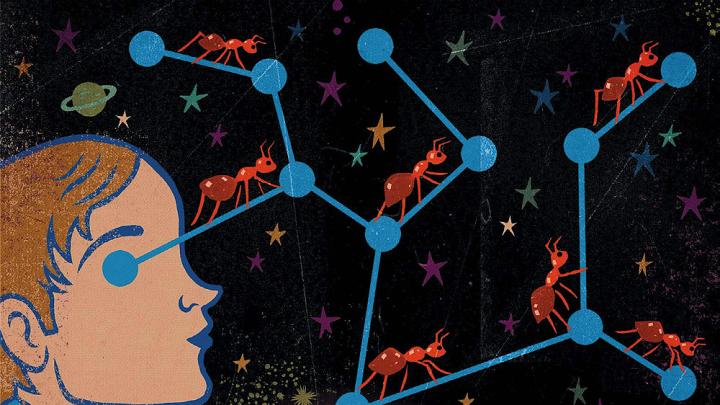Puzzles offer opportunities for exercising mental dexterity while passing the time on rainy days. But Cumrun Vafa sees them in a much deeper light: as tools for understanding the universe itself.
Vafa, the Hollis professor of mathematicks and natural philosophy, is a theoretical physicist who says most of the interesting problems he encounters in physics are puzzles at their core, once the technical language in which they are often cloaked is stripped away. He believes, moreover, that a challenge for theoretical physicists is to translate a problem expressed in terms of complex equations into something akin to a puzzle. “Once I’m able to state the problem in a simple way,” he says, “I have a chance of getting a simple answer.”
That’s the principle behind the freshman seminar, “Physics, Math and Puzzles,” which Vafa has been teaching since 2012. The aim, he notes, “is to introduce physics to a wider audience and to explain complicated aspects of the subject in an accessible way.” Growing up in Iran, Vafa delighted in solving the “brain teasers” presented to him by parents and friends as a form of entertainment. He continued to collect puzzles throughout his academic career before realizing that he could use them as pedagogical tools.
The seminar meetings typically start with students offering solutions to the puzzles assigned for homework, before Vafa explains how each one ties into ideas in physics and math. Students also spend part of each session working in small groups on other puzzles that Vafa has posed, but are always encouraged to bring in new ones. For their final assignment, they are asked to devise an original puzzle that illustrates a concept in physics or math. Thanks to the students’ contributions, Vafa says, the course has “organically evolved” over the years.
Eric Metodiev ’16, A.M. ’16, who has since earned a Ph.D. in physics from MIT, remembers one puzzle from the class quite vividly. Twenty ants are placed on a meter-long stick. All the ants move either to the right or to the left at one meter per minute, and when they collide they reverse directions. How can the ants be positioned to maximize the time before they all fall off? Although the situation seems rather complex, the puzzle can be conceptually simplified by ignoring the identities of individual ants and assuming, instead, that rather than switching directions when two ants meet, they pass through each other, continuing in their original directions. Therefore, the maximum time before all the ants fall off is one minute, which can be achieved simply by placing an ant at one end of the stick and waiting until it reaches the opposite end.
One message Metodiev gleaned from that puzzle is that “the right way of framing a complicated system can sometimes provide an amazingly clear solution.” And cases like this do arise in his current field, particle physics, he says. “You can often simplify problems involving particle collisions and scattering by changing the way you view the system.”
A similar seminar puzzle concerned two containers, each holding a gallon of paint, green in one and white in the other. A person scoops up a cup of green paint and puts it in the white container, and then takes a cup of the mixed white and green paint and puts it in the green container. What is higher—the concentration of green paint in the white container or the concentration of white paint in the green container? This situation also seems complicated until one realizes that the amount of white and green paint does not change. The volume of white paint displaced by green has to equal the volume of green paint displaced by white, so the concentrations are the same.
Puzzles like this introduced Weiming (Wayne) Zhao ’17, A.M. ’17 (now a fourth-year physics graduate student at Princeton) to foundational notions in physics regarding conservation laws, symmetry, and “other ideas I take to heart today. Through simple puzzles with deep implications,” Zhao learned about the value of pure thought and discovered “there’s more to physics than solving crazy differential equations.”
The ant and paint puzzles are two of about 70 Vafa has compiled in Puzzles to Unravel the Universe, a new book based on the course that he wrote to share his ideas beyond the seminar. The physicist Brian Greene ’84, a best-selling author, calls the book “one of the most unusual and captivating approaches I have ever encountered.”
With his book published, Vafa will need to develop new puzzles for this fall’s iteration of the seminar. He looks forward to that, having found that time devoted to puzzles is never wasted. “They always have something to teach us,” he says. “And if we look closely, we can interpret them in ways that give them even more meaning.”








